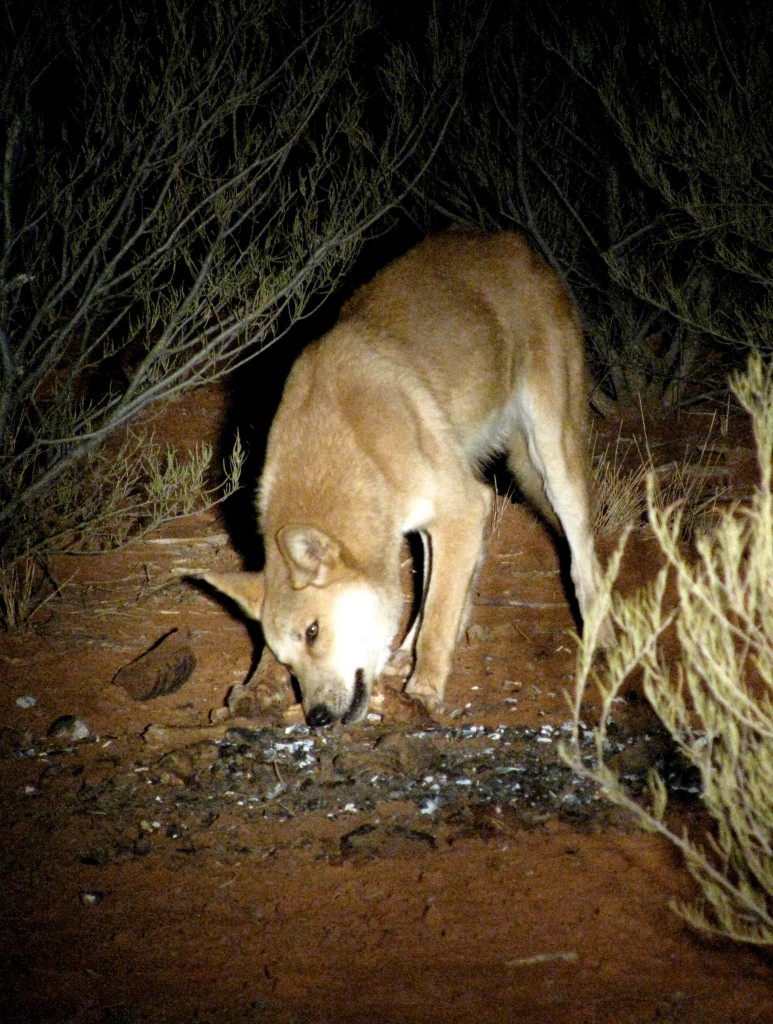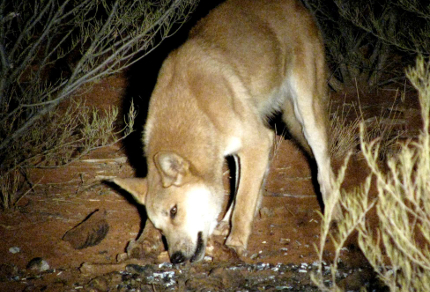
Dingo, Western Australila (© Vilis Nams)
When European settlers herded the first flocks of sheep onto Australian grasslands, they encountered a predator that quickly caught on to the fact that the woolly beasts made a good meal.1 That predator was the dingo. Two hundred years later, Australian sheep and cattle industries are still battling the dingo, except that now they refer to this predator as a ‘wild dog’ because the canids doing the mutton-hunting and calf-killing may be domestic dogs, feral dogs, hunting dogs, purebred dingoes or hybrids of dingoes and dogs.2 In the southern half of the country, most of the wild dogs are dingo/dog mixes, while in the north, it’s more common to encounter purebred dingoes, which now account for less than 20% of the wild dog population.2
An ABC Radio National story that aired this morning reported that wild dogs cause damage to the tune of hundreds of millions of dollars every year.2 It also reported that the wild dog situation may be out of control in Queensland, jeopardizing the state’s sheep and wool industry and causing more and more sheep graziers to convert to beef because of wild dog attacks as well as reduced commodity prices.2 On a national scale, wild dog attacks on livestock have been exacerbated by an increase in size of the predators. In central Australia, wild dogs are 21% larger than they were 30 years ago, while in South Australia, the increase in size is a whopping 30% due to extensive hybridization.2 When Vilis and I visited Riverdale Farm in Victoria in March, Steve Bowran told us that, prior to bringing Maremma guard dogs onto the scene, the family-run, 5000-acre farm had lost 90% of its lambs to wild dogs for six years running. (see http://maginams.ca/2010/03/13/)
In addition to employing guard dogs – which the Bowrans have found to be spectacularly effective in decreasing lamb losses to wild dogs – sheep graziers shoot, poison, and do their best to exclude the predators from their property. In fact, Australia has earned a world fence record with the construction of the Australian Dog Fence, which extends more than 5400 kilometres, from cliffs above the Great Australian Bight in South Australia northeast into Queensland and ending on Darling Downs near Dalby.1 On a map of the country the fence doesn’t look straight by any means; rather it wiggles its way along, fencing off the southeast corner of the continent, including all of Victoria and New South Wales, plus southeastern South Australia and southern Queensland.3 If you stretched it out straight, you could fit two and a half Great Walls of China into the length of it.1 Although the idea of the fence is to keep wild dogs to the north and west of it – out of southeastern prime sheep country – plenty have penetrated the fence or cropped up inside it, as the Bowrans have experienced.
The fence has a long history. About 120 years ago, sheep farmers grazing valuable Merino sheep to provide wool for the European textile industry built ‘vermin fences’ around individual properties to protect the sheep.1 Later, farmers living in close proximity worked together to fence off cells of properties, and still later, even larger groupings of landowners created vermin districts. At the peak of the fencing efforts, more than 30,000 miles of dog fences had been erected, but these were replaced in 1946 by one single-line fence – the Australian Dog Fence.1
The dingo/wild dog conundrum is an interesting one. Dingoes were introduced to Australia by Aboriginals about 4,000 years ago.4 During the 3000-plus years after their arrival but before the invasion of Terra Australis by Europeans, the dingoes became an integral part of the ecology of Australia. Once sheep entered the picture, however, dingoes became ‘vermin’ to be exterminated, a thought still propounded by many sheep and cattle graziers today. There are some, though, like the owners of Cunyu Station in Western Australia where Vilis and Janis sampled biodiversity in June, who believe that dingoes play a pivotal role in controlling macropod populations, thus resulting in better grazing for livestock. From a biological point of view, there’s good preliminary evidence that the presence of dingoes decreases the numbers of feral cats and introduced red foxes, both of which are devastating predators of native Australian small mammals.5 Studies conducted by Drs. Chris Johnson and Euan Ritchie of James Cook University (Vilis and Janis assisted Euan with one of these studies in Western Australia in late May and early June) appear to indicate that within a given region, biodiversity is higher on cattle stations where dingoes are not controlled than on stations where they are controlled.5 As I said, the dingo/wild dog conundrum is an interesting one. It’s all a matter of perspective.
References:
1. Australia Network. Dog Fence. © ABC 2009. Accessed 21-Jul-2010. http://australianetwork.com/nexus/stories/s1871621.htm
2. ABC Radio National Breakfast. Australia’s wild dog population out of control (2010). Accessed 16-Jul-2010. http://www.abc.net.au/rn/breakfast/stories/2010/2953987.htm
3. Wikipedia. Dingo Fence. Updated 20-Jun-2010. Accessed 21-Jun-2010. http://en.wikipedia.org/wiki/Dingo_Fence
4. Chris Johnson. Australia’s Mammal Extinctions: A 50 000 year history. Cambridge University Press, Cambridge, p. 168.
5. Dr. Chris Johnson, School of Marine and Tropical Biology, James Cook University. Personal communication.


